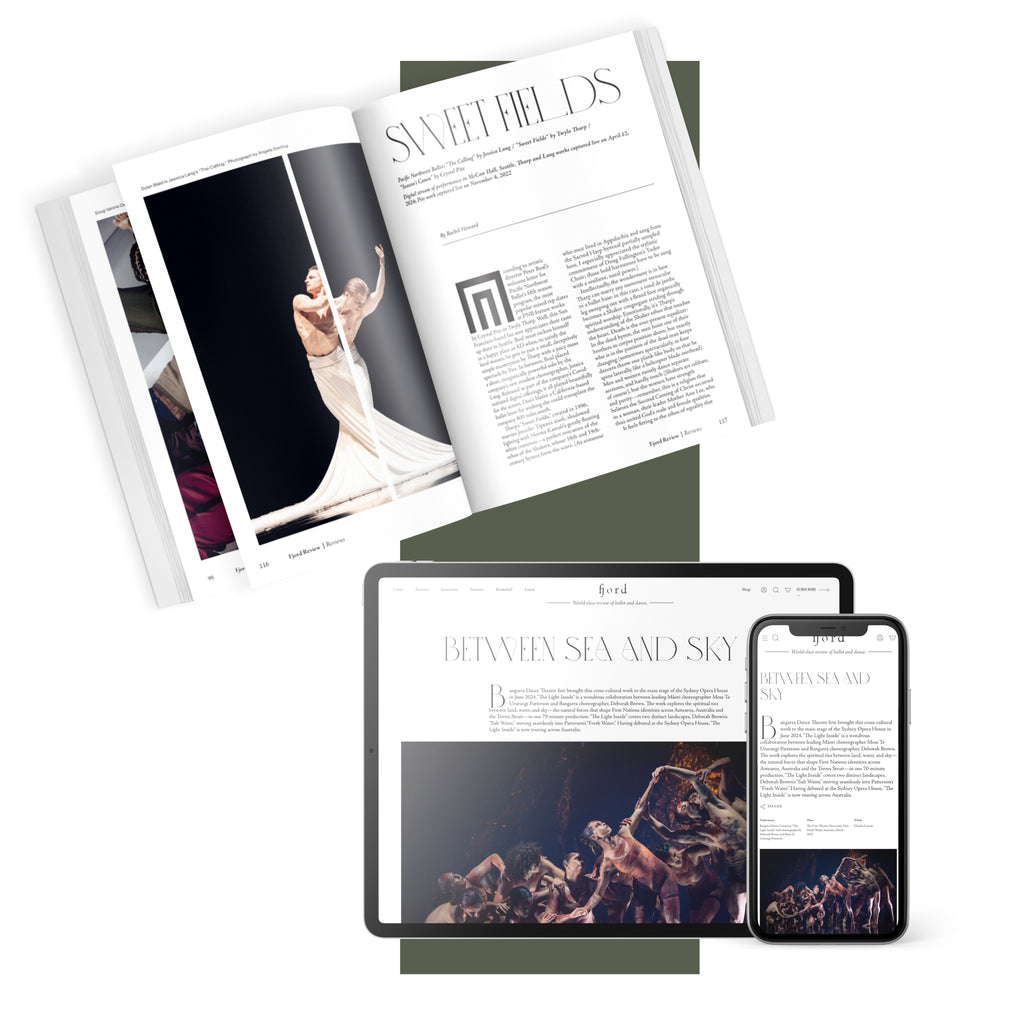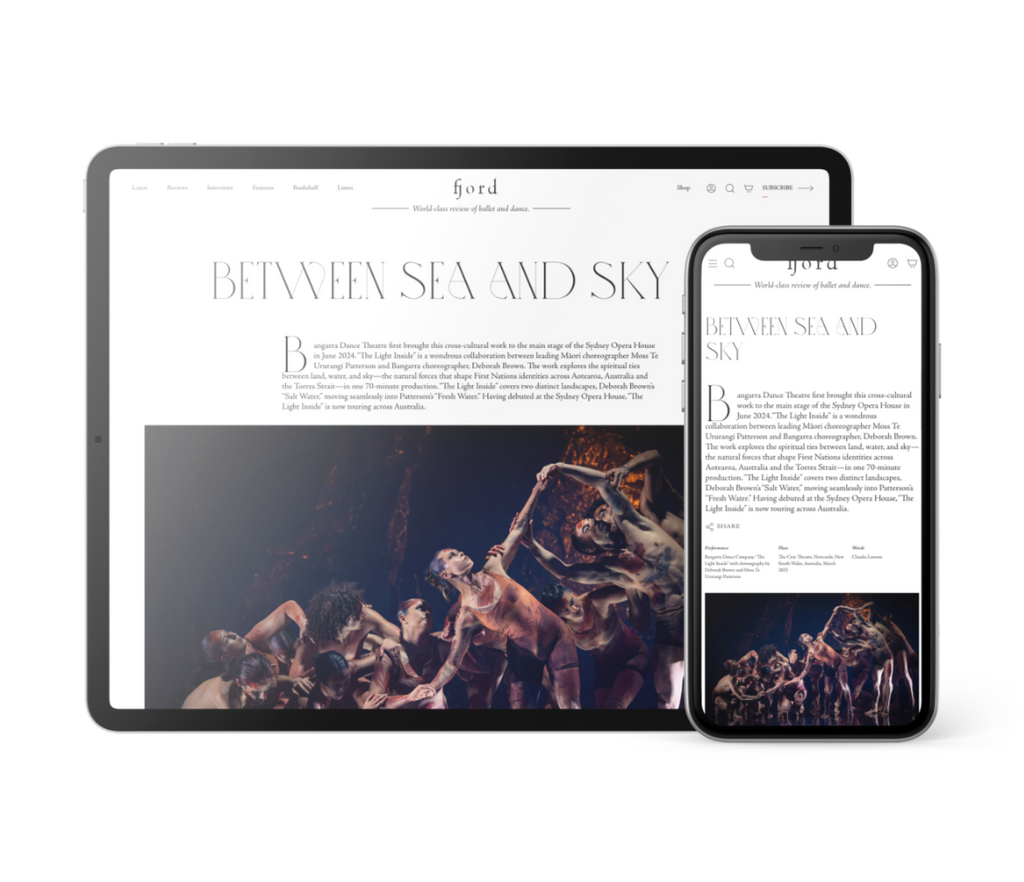Also odd: Orlando is a love letter, written for and dedicated to Woolf’s paramour Vita Sackville-West (though both were married to men). Photos of Sackville-West were incorporated into the text of the novel, and it was so overtly gushy that her mother begged the editor of The Observer not to review the book. Yet McGregor’s “Becomings” was devoid of emotion. The dancers were darkly lit and further obscured by smoke and lasers (the production design was by We Not I, Lucy Carter did the lighting). The steps were sexy but detachedly performed. For a ballet based on a heated lesbian affair, it was ironic that the best passage was an abstract, heterosexual pas de deux (fabulously performed by Chloe Misseldine and Royal). McGregor apparently took the gynomorphic/time-traveling aspects of Orlando as license to create a borderline sci-fi realm of exaggerated lines and contemporary technique. I enjoyed this fierce club scene for a bit, but the dance dragged. Woolf described Orlando in her diary as “gay & quick reading,” but “Becomings” became a lugubrious slog. Except for the gender-bending period costumes by Moritz Junge, the playful spirit of Orlando was lost.
McGregor’s deviations from Woolf’s text worked better in “Tuesday.” Eliding The Waves’s characters and centering the piece on Woolf’s own death was bold, but McGregor sold it. He pulled it off even though the final passage in The Waves is Bernard’s defiant raging against death despite his middle-aged malaise. But McGregor was right to assume that this battle cry is a little disingenuous, rather like when Kurt Cobain sang “I swear that I don’t have a gun” in “Come as You Are.” For, Woolf’s darkness is eminent in all three of these novels and beyond. Clarissa, Septimus, Orlando, and The Waves characters are obsessed with death—often watery death, as when Septimus murmurs “Now we will kill ourselves” as he longingly eyes the river in Mrs. Dalloway, much to the horror of his wife Rezia. Rhoda also kills herself in The Waves, and though it is ultimately unclear how, she fantasizes: “We may sink and settle on the waves. The sea will drum in my ears. The white petals will be darkened with sea water. They will float for a moment and then sink. Rolling me over the waves will shoulder me under. Everything falls in a tremendous shower, dissolving me.”
Woolf’s novels are threaded with wave imagery, and McGregor aptly wove undulating moves into all three sections of “Woolf Works” too. I loved a flat-footed lean back in attitude front in “I now, I then” that was echoed by both Clarissas and Sally. They rocked back and forth in a canon like the tides. There was also a pike lift that dipped like a happy dolphin, executed by Clarissa and Richard as well as Clarissa and Peter. It was then echoed by Trenary and Cornejo in “Tuesday.” Indeed, there were plunging, rolling spines all through “Becomings.” And in every section, McGregor featured plashing lower legs like mermaid tails, with the dances’ gorgeously arched feet calling to mind Woolf’s refrain of a “fin in a waste of waters” in The Waves.
McGregor utilized the large corps de ballet in “Tuesday” like a roiling sea. Likewise, in this section Max Richter’s score was ingeniously constructed around rippling, sonic waves. McGregor’s choice to commission Richter for this ballet was one of his best coups. For, like Woolf, Richter has been obsessed with memory, nature cycles, and the passage of time for the whole of his career (a shortlist of his works includes “Memoryhouse,” “Songs from Before,” and “On the Nature of Daylight”—which could be a subtitle for The Waves). Richter’s score also featured voiceover, but not from The Waves. The actress Gillian Anderson vividly read Woolf’s suicide letter, firmly establishing McGregor’s focus on Woolf’s personal life in “Becomings.”
Ocean imagery whirled around Trenary as Woolf, who, clad in a sheer black slip dress, interacted with important figures in her life as they drifted in and out. Cornejo returned as her husband Leonard for two fluid pas de deux. In the closing one, he laid Trenary gently down under the large video screen of slow-motion waves (designed by Ravi Deepres). Isabella Boylston also appeared with children from the ABT Jacqueline Kennedy Onassis School to represent the starkly different, maternal path taken by Woolf’s sister, Vanessa Bell.
Trenary was luminous in “Tuesday,” and her own imminent departure from ABT gave this section even more weight. She is to join the Vienna State Opera Ballet, which now happens to be under the directorship of the original “Woolf Works” Woolf, Alessandra Ferri. Like a latter-day Ferri, Trenary is a gifted actress; her absence will be felt in ABT’s narratively inclined summer seasons. It was sad to think that this was the end of Trenary’s fruitful partnership with Cornejo as well. When Trenary sat and untied her pointe shoes onstage it was heavy—even moreso than that final, submerged repose. It symbolized the small death that all ballerinas must face, even if, like Ferri, they don’t face it until very late. Here, McGregor hit upon the perfect gesture to broadcast this ballerina-Woolf’s readiness to cast off her mortality. Though Trenary’s back was towards the audience as she unlaced her ribbons, I imagined the soft falling of those rippling, satiny waves too.
However, it was simultaneously exciting to think of the new partnership Trenary will forge with Ferri. This development cast “Tuesday” in a much more hopeful light than it wanted to operate, suggesting auspicious cycles of mentorship and artistic renewal. And yet, this emotional tug-of-war surrounding Trenary’s future might have been the most Woolfian thing of all. At this serendipitous June performance, the lives of multiple characters, creators, and performers—Clarissa and Woolf, McGregor and Richter, Ferri and Trenary—churned and swirled in symphonic splendor, just like the characters in The Waves.
The moment when Trenary removed her second skin-like, yet restrictive, footwear—oh, the freedom of bare feet!—the act communicated some glimmer of the resignation and counterintuitive liberation Woolf must have felt when she walked into the River Ouse in March of 1941. As this passage from the beginning of Dalloway attests, Woolf had been dancing around the idea for some time.
So on a summer’s day waves collect, overbalance, and fall; collect and fall; and the whole world seems to be saying ‘that is all’ more and more ponderously, until even the heart in the body which lies in the sun on the beach says too, That is all. Fear no more, says the heart. Fear no more, says the heart, committing its burden to some sea, which sighs collectively for all sorrows, and renews, begins, collects, lets fall.”
*For the incomparable Woolf scholar Anne Fernald, with whom I was fortunate enough to study.





Astonishing commentary, not least for reviewer’s skill in juxtaposing two different art forms and giving each is own life.
Thank you for your depth of engagement and your brilliance.